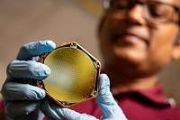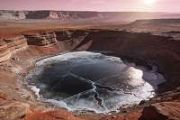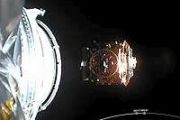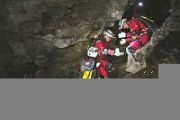
Copernical Team
UVA professor aims to boost next-generation space rockets
 Go faster, farther, more efficiently.
That's the goal driving spacecraft propulsion engineers like Chen Cui, a new assistant professor at the University of Virginia School of Engineering and Applied Science. Cui is exploring ways to improve electric propulsion thrusters - a key technology for future space missions.
"In order to ensure the technology remains viable for long-term missi
Go faster, farther, more efficiently.
That's the goal driving spacecraft propulsion engineers like Chen Cui, a new assistant professor at the University of Virginia School of Engineering and Applied Science. Cui is exploring ways to improve electric propulsion thrusters - a key technology for future space missions.
"In order to ensure the technology remains viable for long-term missi India unveils plans for 10 missions in 2025 after successful space-docking launch
 India's space agency says it is planning a record 10 orbital missions, as well as its first commercial effort, during 2025 after successfully launching a space-docking project this week.
Indian Space Research Organization chairman S. Somanath told reporters following Monday's launch of a PSLV-C60 rocket carrying Space Docking Experiment, or SpaDeX, payloads, that the nation has big plan
India's space agency says it is planning a record 10 orbital missions, as well as its first commercial effort, during 2025 after successfully launching a space-docking project this week.
Indian Space Research Organization chairman S. Somanath told reporters following Monday's launch of a PSLV-C60 rocket carrying Space Docking Experiment, or SpaDeX, payloads, that the nation has big plan See and hear three years of solar fireworks
 Video:
00:01:14
Video:
00:01:14
At the start of this new year, we look back at close-up pictures and solar flare data recorded by the ESA-led Solar Orbiter mission over the last three years. See and hear for yourself how the number of flares and their intensity increase, a clear sign of the Sun approaching the peak of the 11-year solar cycle.
This video combines ultraviolet images of the Sun's outer atmosphere (the corona, yellow) taken by Solar Orbiter's Extreme Ultraviolet Imager (EUI) instrument, with the size and locations of solar flares (blue circles) as recorded by the Spectrometer/Telescope for Imaging X-rays (STIX) instrument. The
Robot rock at LUNA
 Image:
Image:
ESA's robots get ready to rock at LUNA.
Also known as the Moon on Earth, the LUNA facility near the European Astronaut Centre (EAC) in Cologne, Germany, was unveiled in September 2024, a simulated lunar environment that prepares our return to the Moon. To celebrate, ESA astronaut Matthias Maurer joined forces with our robotics experts to showcase their cutting-edge machines Interact and Spot, and the potential of human-robot teamwork for space exploration.
Meet ESA’s robots: Interact, a wheeled robotic arm, and Spot, a robot dog. ESA’s robotics team in the Netherlands programs these machines for human-robot interaction experiments such as
Pale blue (supernova) dot
 Image:
Pale blue (supernova) dot
Image:
Pale blue (supernova) dot Chinese satellite network enhances maritime internet connectivity
 Spacesail Constellation, a Chinese commercial low-orbit satellite network, has successfully completed its inaugural network connection test, demonstrating the system's capability to support high-speed broadband services for maritime applications.
The test, conducted by Shanghai Spacesail Technologies Co., Ltd., assessed the ability of the satellite broadband network to deliver internet con
Spacesail Constellation, a Chinese commercial low-orbit satellite network, has successfully completed its inaugural network connection test, demonstrating the system's capability to support high-speed broadband services for maritime applications.
The test, conducted by Shanghai Spacesail Technologies Co., Ltd., assessed the ability of the satellite broadband network to deliver internet con Intuitive Machines enhances lunar and deep space data transmission services
 Intuitive Machines, Inc. (Nasdaq: LUNR, LUNRW), a leader in space exploration, infrastructure, and services, has expanded its collaboration with NASA by securing additional contracts from the Near Space Network (NSN) to provide Direct-to-Earth (DTE) services. These agreements underscore the company's integral role in advancing NASA's lunar and deep space missions.
DTE communication and nav
Intuitive Machines, Inc. (Nasdaq: LUNR, LUNRW), a leader in space exploration, infrastructure, and services, has expanded its collaboration with NASA by securing additional contracts from the Near Space Network (NSN) to provide Direct-to-Earth (DTE) services. These agreements underscore the company's integral role in advancing NASA's lunar and deep space missions.
DTE communication and nav India's space economy to grow nearly 5 times in next decade
 The Indian space economy is set to grow nearly 5 times from $8.4 billion to around $44 billion in the next decade, Union Minister of State for Science and Technology, Dr Jitendra Singh, has stressed.
Investments in the sector reached Rs 1,000 crore in 2023 alone, placing India as a frontline player globally. India's space sector has also emerged as a significant foreign exchange earner.
O
The Indian space economy is set to grow nearly 5 times from $8.4 billion to around $44 billion in the next decade, Union Minister of State for Science and Technology, Dr Jitendra Singh, has stressed.
Investments in the sector reached Rs 1,000 crore in 2023 alone, placing India as a frontline player globally. India's space sector has also emerged as a significant foreign exchange earner.
O Gilat secures $18M in orders for In-Flight Connectivity Solutions
 Gilat Satellite Networks Ltd. (NASDAQ, TASE: GILT), a global leader in satellite networking technology and services, has announced securing more than $18 million in orders for in-flight connectivity (IFC) solutions. These orders primarily involve Gilat's advanced SkyEdge platforms, associated services, and Solid State Power Amplifiers (SSPAs). The company plans to deliver the equipment and servi
Gilat Satellite Networks Ltd. (NASDAQ, TASE: GILT), a global leader in satellite networking technology and services, has announced securing more than $18 million in orders for in-flight connectivity (IFC) solutions. These orders primarily involve Gilat's advanced SkyEdge platforms, associated services, and Solid State Power Amplifiers (SSPAs). The company plans to deliver the equipment and servi MIT scientists pin down the origins of a fast radio burst
 Fast radio bursts are brief and brilliant explosions of radio waves emitted by extremely compact objects such as neutron stars and possibly black holes. These fleeting fireworks last for just a thousandth of a second and can carry an enormous amount of energy - enough to briefly outshine entire galaxies.
Since the first fast radio burst (FRB) was discovered in 2007, astronomers have detect
Fast radio bursts are brief and brilliant explosions of radio waves emitted by extremely compact objects such as neutron stars and possibly black holes. These fleeting fireworks last for just a thousandth of a second and can carry an enormous amount of energy - enough to briefly outshine entire galaxies.
Since the first fast radio burst (FRB) was discovered in 2007, astronomers have detect 



































